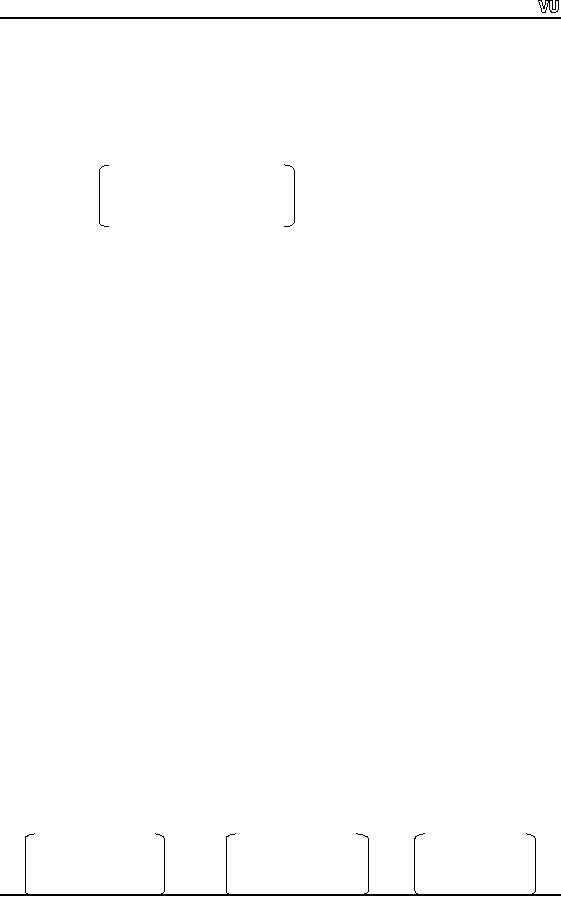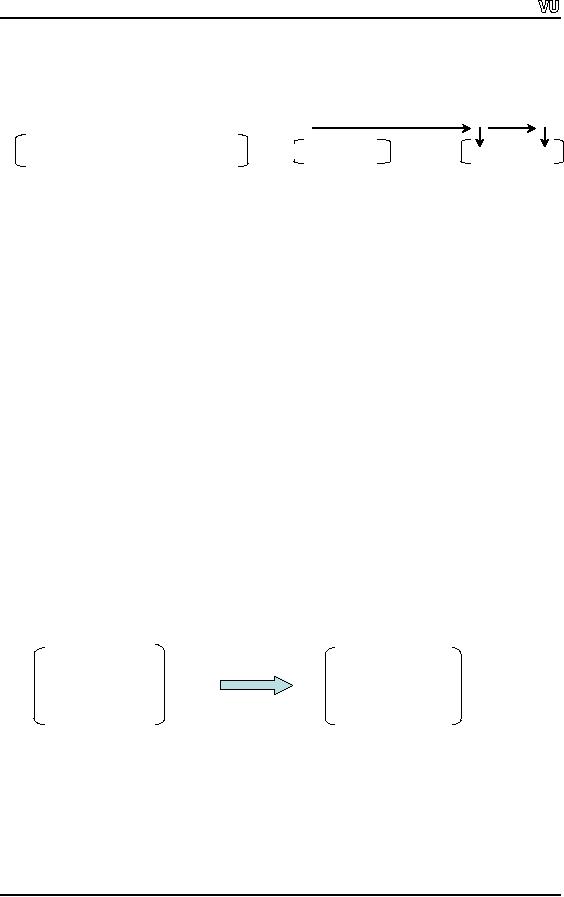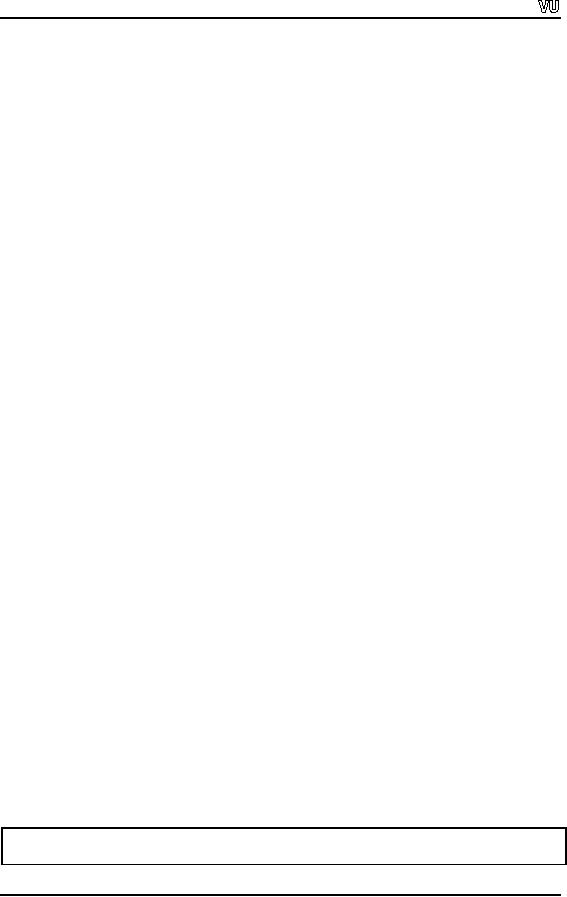 |

CS201
Introduction to Programming
Lecture
Handout
Introduction
to Programming
Lecture
No. 43
Reading
Material
Lecture 1,
Lecture 25 - Lecture 42
Summary
�
Programming
Exercise - Matrices
�
Design
Recipe
�
Problem
Analysis
�
Design
Issues and Class
Interface
Programming
Exercise - Matrices
Mathematics is a
good domain to develop different
classes and programs. For
example,
solutions
for Complex numbers,
Matrices and Quadratic
Equations can be sought
for
developing
our own classes. In this
lecture, we will take a
problem to manipulate and
perform
different operations on Matrices.
Matrices are used in lot of
real world problems.
We will
perform problem analysis,
design and
implementation.
Let's
take a look at analysis and
design phases first by using
our design recipe.
Design
Recipe
Firstly
we do analysis and try to
come up with a problem statement.
Express its essence,
abstractly
and with examples. After describing
the problems in few sentences, we
try to
formulate
the problem with examples. It is
emphasized to pay attention to
the details. We
do
analysis of the data
structures to be used in the program
and choose the best
fit to the
program
requirements. The code is
written to implement the
program. After
implementation
is completed, we do its testing to verify
that it is behaving properly in
all
scenarios.
If any bugs are found, they
are fixed. This cycle of
testing and bug
fixing
continues
until the program is working
perfectly without any
problem.
We are
going to write a program to manage
operations on Matrices.
Page
552

CS201
Introduction to Programming
At the
start of the problem analysis
phase, let's try to
understand the problem domain
first.
Problem
Analysis
A matrix
is nothing but a two-dimensional array of
numbers. It is normally represented
in
rows
and columns. A matrix is represented
as:
1
2
3
4
A=
5
6
7
8
9
10
11
12
It is a
matrix A
with 3
rows and 4 columns. So order of
the matrix is 3 * 4.
Before going further,
let's consider what are
the operations normally performed
on
matrices.
- A matrix is
added to another
matrix.
- A scalar
value (an ordinary number) is
added to a matrix.
- A matrix is
subtracted from another
matrix.
- A scalar
number is subtracted from a
matrix.
- A matrix is
multiplied with another
matrix.
- A scalar
number is multiplied with a
matrix.
- A matrix is
divided by a scalar.
- A matrix is
transposed.
Now, we
will define what these
operations are and if there
are any restrictions on
matrices
performing these
operations.
The
sum or addition of two
matrices of the same order
is found by adding the
corresponding
elements of the two matrices. If
A
and
B
are
two matrices of order m * n to
be added
then their resultant matrix
will also have the
same order m * n.
Aij + Bij
Where i
varies from 1 to m (max
number of rows) and j varies
from 1 to n (max
number
of
cols).
Clearly,
there is a restriction on the matrices
performing this addition
operation that they
should
have same numbers of rows
and columns, in other words their
order should be the
same.
There is
another operation of addition of
scalar number to a matrix. In
this operation, a
number is
added to all elements of the
matrix.
Subtraction
operation works in the same
fashion that two matrices of
the same order
takes
part in
this operation and resultant
matrix with similar order is
obtained by subtracting
each
element of one matrix from
the corresponding element of
other matrix. For
example,
see
the subtraction operation
and assignment below:
Cij = Aij - Bij
1
2
3
3
6
8
-2
-4
-5
5
6
7
7
4
7
-2
2
0
=
-
9
10
11
9
10
1
0
0
10
Page
553

CS201
Introduction to Programming
Not to
confuse your understanding
with assignment in computer programs,
the resultant
matrix is
put on the left of
assignment operator otherwise in Mathematics it is
located on
the
right.
Each
element of matrix B
is
subtracted from the
corresponding element of the
matrix A
and
the resultant goes to matrix
C. C
will
have the same number of
rows and columns as
A
and
B.
Similar
to the addition, there is another
operation for subtracting a
scalar from a matrix.
In this
case, a number is subtracted
from each element of the
matrix.
For
Division of a matrix by a scalar,
the scalar number divides
each element of the
matrix.
Let x
be a
scalar number and A
be a
matrix then division is
represented as:
Cij = Aij / x
Each
element of matrix A
is
divided by the number x
to
produce the
corresponding
number in
the resultant matrix C. For
example, A11 (element
in first row and first
column
of matrix
A) is divided by the scalar
number x
to
provide C11 (element in first
row and
first
column of matrix C).
The
multiplication operation is bit
complicated as compared to the above
discussed
operations.
We will discuss simple case
first, when a scalar is
multiplied by a matrix.
Suppose,
this time we want to multiply
the scalar x
with
the matrix A
as:
Cij = x * Aij
Each
element of matrix A
is
multiplied with the scalar
x
and
the resultant number is put
in
the
corresponding location inside the
matrix C.
Now, we
will see how a matrix is
multiplied with another
matrix. Firstly, there is
a
restriction on
order of the matrices involved in
this operation. The number
of columns of
the
first matrix should be equal
to the number of rows of the
second matrix.
Two
matrices are multiplied in the
following manner:
We take
the first row of first
matrix and multiply it with
the first column of the
second
matrix.
The multiplication is done in
such a way that the
first element of the row
is
multiplied
with the first element of
the column, second element
is multiplied with
the
second
element and so on. The
results of all these
multiplication operations are
added to
produce
one number. The resultant
number is placed at the
corresponding position (i.e. 1st
row
1st col in this
case) in the resultant
matrix.
Further
the same first row is
multiplied with the second
column of the second matrix
and
the
resultant number is placed at
intersecting position of first row
and second column in
the
resultant matrix. This
process goes on till the
last column of the second
matrix.
Page
554

CS201
Introduction to Programming
Then
comes the second row of
first matrix and whole
operation is repeated for
this row,
this
row is multiplied with all
the columns of the second
matrix. This process goes on
till
the
last row of the first
matrix.
(1)(2)+(2)(1)
(1)(4)+(2)(2)
2
4
1
2
*
1
2
5
6
(5)(2)+(6)(1)
(5)(4)+(6)(2)
Note
the resultant matrix is put
on the left of the =. In Mathematics,
this is put on right
but
not to confuse your
understanding with assignment
concept in computer programs, it
is put on
left.
If a
matrix with order m
rows,
n
columns is
multiplied with another
matrix of n
rows
and
p
columns
then the resultant matrix
will have m
rows
and p
columns. In
the above
diagram,
the first matrix has
two rows and second
matrix has two columns,
therefore, the
resultant
matrix has two rows
and two columns.
Now
comes the last operation, we
are thinking of implementing i.e.
Transpose of a
matrix.
Transpose of a matrix is obtained by
interchanging its rows and columns.
How do
we
interchange rows and columns
for transposing the matrix?
We take the first row of
the
matrix
and write it as a first
column of the new matrix.
The second row of the
original
matrix is
written as second column of
the new matrix and
similarly the last row of
the
original
matrix is written as last
column of the new matrix. At
the end of this
operation,
when
all rows of the original
matrix are finished, we have
new matrix as transpose of
the
original
matrix. There is no change in
the size (order or number of
rows and cols of a
matrix)
of the transposed matrix
when the original matrix is
a square matrix. But
when
the
original matrix is not a
square matrix, there is a
change in the order of the
transposed
matrix.
The number of rows of the
original matrix becomes the
number of columns of the
transposed
matrix and the number of
columns of the original matrix
becomes the number
of rows
of the transposed
matrix.
1
2
3
1
5
9
5
6
7
2
6
10
9
10
11
3
7
11
Until
now in this problem analysis
phase, we have analyzed the
problem in order to
understand
what are the matrices and
what are their operations to be
implemented. Now
at the
next stage, we try to
determine the
followings:
- What are
the constants to be used in
our class?
- What are
going to be the data structures to
cater to the different sized
matrices?
- How much
memory is required and how
it will be allocated?
Page
555

CS201
Introduction to Programming
What is
going to be the interface of the
class?
-
Design
Issues and Class
Interface
We want
to specify the size of the matrix at
creation time and allocate
the memory for
that. So
we don't see any use of
constants inside our class
named Matrix.
The size
of the memory to be allocated is
not going to be huge, as we are
not catering to
the
very huge sized matrices.
Therefore, the memory for a
matrix is going to be allocated
dynamically
bluntly after the size of
the matrix is specified in terms of
rows and columns
without
worrying about the size of
the matrix.
For
the interface of our Matrix
class, we
will declare a constructor
that will accept
integer
number of
rows and columns of the
matrix to be created as
parameters.
Matrix
( int rows, int cols )
;
The
constructor function will be doing
the memory allocation for
the matrix.
As part
of the interface, we will
declare a display function inside
our Matrix
class
that
will
display the elements on the
screen.
void
display ( Matrix & );
To
perform already discussed
different operations on matrices, we need
to overload
operators.
For example to perform addition of two
matrices, + operator
will
be
overloaded
as a member function of the Matrix
class.
The + operator
function
will be
called
for the Matrix
object on
the left of the +
and
the Matrix
object on
the right to it
will be
passed as a parameter to it.
This function will add
the corresponding elements
of
the
both matrices and returns
the resultant back.
Matrix
operator + ( Matrix & ) const;
The
same thing applies to the
subtraction operation of two
matrices. operator
function
will be
overloaded for that as a member
function of the Matrix
class.
Matrix
operator - ( Matrix & ) const;
The
situation changes a bit, when we
want to write the functions to
cater to different
operations
where both the operands are
not matrix objects rather
one of them is scalar.
For
example, when we want to do the
following operation:
A +
x;
Where A
is a matrix and x is a
scalar.
Then we
write a member function that
accepts a scalar number as a
parameter instead of a
Matrix
object.
Page
556

CS201
Introduction to Programming
Matrix
operator + (
Scalar ) const;
The
Scalar can be an int, double
or
float, that we
will cover later.
But
the situation is more different,
when we want to perform the
scalar addition
operation
in the
following manner:
x +
A;
By now we
should be clear that member
function cannot be written to
handle this
operation
because there is a scalar
number on the left of +.
Therefore, we need to write
a
friend
operator function
for this type of operation.
The friend functions are
non-members
and
therefore, defined outside of
the class.
friend
Matrix operator + ( Scalar , Matrix & )
;
Similarly,
when a scalar is subtracted
from a Matrix
object
like the following:
A -
x;
A member
function is written to cater to
this operation.
Matrix
operator - ( Scalar ) const;
But
again, when a matrix is
subtracted from a scalar
number:
x -
A;
Then we
have to write a friend
operator to handle
this operation.
friend
Matrix operator - ( Scalar , Matrix & )
;
In order
handle the multiplication
operations of two Matrix
objects like the
following:
A *
B;
A member
operator *
function
is defined.
Matrix
operator * ( const Matrix & )
;
This
operator is called for the
Matrix
object on
the left of *
and
the object on the right
is
passed as
an argument. The function
multiplies both the matrices
and returns the
resultant
matrix.
When a
scalar is multiplied with a
scalar like:
A *
x;
Page
557

CS201
Introduction to Programming
The
following member operator * handles
this:
Matrix
operator * (
Scalar ) const;
But
for operation like the
following:
x *
A;
following
friend operator
function
is written:
friend
Matrix operator * ( const Scalar , const
Matrix & ) ;
For
division operation like the
following:
A /
x;
A member
operator / is overloaded
as:
Matrix
operator / (
const Scalar );
Now we
will talk about transpose of
a matrix. For this
operation, we will write a
member
function
transpose
that
will transpose the original
matrix.
Matrix
& transpose(void) ;
Now we
are left with few more
things to cover to complete the rudimentary
interface of
our
class Matrix.
Operators
+=
and
-=
are
overloaded as member operators. These
composite operators
use
the assignment operator ( =
).
We will
also overload stream insertion
and extraction operators as friend
functions to
our
Matrix
class as
follows:
friend
ostream & operator << ( ostream & ,
Matrix & ) ;
friend
istream & operator
>> (
istream & , Matrix & ) ;
So here
is how we declare our Matrix
class.
The interface of the class
is the public
methods
of the class. Here is one
important point to understand
that what we are
concerned
about here is the class
interface and not about
the program interface to the
user
of the
program. A programmer can develop
user interface by writing
his/her code while
using
the class interface.
/* Declaration of
the Matrix class. This
class is containing the double
type elements */
Page
558

CS201
Introduction to Programming
class
Matrix
{
private:
int
numRows, numCols;
double
**elements;
public:
Matrix(int=0,
int=0);
// default
constructor
Matrix(const
Matrix & );
// copy
constructor
~Matrix();
//
Destructor
int
getRows(void) const;
//
Utility fn, returns no. of
rows
int
getCols(void) const; // Utility fn,
returns no. of columns
const
Matrix & input(istream &is = cin); //
Read matrix from
istream
const
Matrix & input(ifstream
&is);
// Read
matrix from istream
void
output(ofstream &os) const;
//
Utility fn, prints matrix
with graphics
void
output(ostream &os = cout) const; //
Utility fn, prints matrix
with graphics
const
Matrix& transpose(void);
//
Transpose the matrix and
return a ref
const
Matrix & operator = (const
Matrix &m);
//
Assignment operator
Matrix
operator+( Matrix &m)
const;
// Member
op + for A+B; returns
matrix
Matrix
operator + (double d)
const;
const
Matrix & operator += (Matrix
&m);
friend
Matrix operator + (double d,
Matrix &m);
Matrix
operator-( Matrix & m)
const;
// Member
op + for A+B; returns
matrix
Matrix
operator - (double d)
const;
const
Matrix & operator -= (Matrix
&m);
friend
Matrix operator - (double d, Matrix&
m);
Matrix
operator*(const Matrix & m);
Matrix
operator * (double d)
const;
friend
Matrix operator * (const
double d, const Matrix&
m);
Matrix
operator/(const double d);
friend
ostream & operator << ( ostream
& , Matrix & );
friend
istream & operator >> ( istream & ,
Matrix & );
friend
ofstream & operator << (
ofstream & , Matrix & );
friend
ifstream & operator >> (
ifstream & , Matrix & );
void
display( ) ;
};
In the
above declarations, we should
note how we are passing
and returning Matrix
objects.
We are passing and returning
the Matrix objects by
reference because passing
the
Page
559

CS201
Introduction to Programming
Matrix
objects by value will be a
overhead that will affect
performance and more
memory
will be allocated and
de-allocated on stack.
Notice
that we are doing dynamic
memory allocation inside the
constructor
of
the class.
You must
be remembering that wherever the dynamic
memory allocation is made, it
has
to be
freed explicitly. To de-allocate
the memory, we will write
code inside the destructor
of the
class Matrix. The
other consideration when we
are allocating memory on
free store
from
within constructor is that
the default assignment
operator will
not work here.
Remember,
the default assignment
operator makes
shallow
copy of the
object members,
therefore,
we will have to write our
own assignment
operator ( = ) in
order to make deep
copy
of
the object data members.
Remember that a copy
constructor is called
when a new
Matrix
object is
initialized and constructed
based on an already existent Matrix
object.
Therefore,
we have to write our own
copy
constructor in order
to make deep copy of
the
object
data members.
There is
one very important point to
mention about this class
Matrix. A Matrix
can
be
composed
of ints, floats or doubles as their
elements. Instead of handling these
data types
separately,
we can write Matrix
class as
a template class and write
code once for
all
native
data types. While writing
this template class, the
better approach to write
will be,
to go
with a simple data type
(e.g. double) first
to write a Matrix
class
and then extend it
to a
template class later.
Another thing that can be
templatized in the Matrix
class is
the
Scalar
number.
Actually, this Scalar number
can be an int, float
or
double;
therefore, we
may
also use a template for
this.
We have
to perform certain checks
and make decisions inside
the implementation of
member functions.
For example, while writing
the division operator member
function, we
will
check against the number
that it should be non-zero. Before
adding two matrices,
we
will
check for their number of
rows and columns to be equal.
Also in this exercise,
we
have
declared only one class
Matrix
to
manipulate matrices. There are
alternate
approaches
to this. For example, we could declare a
Row
class
first and then
contain
multiple
objects (same in number as
number of rows required for
the matrix object) of
Row
class
inside the Matrix
class
making a matrix of a certain size. To
make it simple,
we have
selected to manage matrices using
only one class Matrix. The
objective here is to
practice
the already studied
programming constructs as much as
possible.
Page
560
Table of Contents:
- What is programming
- System Software, Application Software, C language
- C language: Variables, Data Types, Arithmetic Operators, Precedence of Operators
- C++: Examples of Expressions, Use of Operators
- Flow Charting, if/else structure, Logical Operators
- Repetition Structure (Loop), Overflow Condition, Infinite Loop, Properties of While loop, Flow Chart
- Do-While Statement, for Statement, Increment/decrement Operators
- Switch Statement, Break Statement, Continue Statement, Rules for structured Programming/Flow Charting
- Functions in C: Structure of a Function, Declaration and Definition of a Function
- Header Files, Scope of Identifiers, Functions, Call by Value, Call by Reference
- Arrays: Initialization of Arrays, Copying Arrays, Linear Search
- Character Arrays: Arrays Comparisonm, Sorting Arrays Searching arrays, Functions arrays, Multidimensional Arrays
- Array Manipulation, Real World Problem and Design Recipe
- Pointers: Declaration of Pointers, Bubble Sort Example, Pointers and Call By Reference
- Introduction, Relationship between Pointers and Arrays, Pointer Expressions and Arithmetic, Pointers Comparison, Pointer, String and Arrays
- Multi-dimensional Arrays, Pointers to Pointers, Command-line Arguments
- String Handling, String Manipulation Functions, Character Handling Functions, String Conversion Functions
- Files: Text File Handling, Output File Handling
- Sequential Access Files, Random Access Files, Setting the Position in a File, seekg() and tellg() Functions
- Structures, Declaration of a Structure, Initializing Structures, Functions and structures, Arrays of structures, sizeof operator
- Bit Manipulation Operators, AND Operator, OR Operator, Exclusive OR Operator, NOT Operator Bit Flags Masking Unsigned Integers
- Bitwise Manipulation and Assignment Operator, Programming Constructs
- Pre-processor, include directive, define directive, Other Preprocessor Directives, Macros
- Dynamic Memory Allocation, calloc, malloc, realloc Function, Dangling Pointers
- History of C/C++, Structured Programming, Default Function Arguments
- Classes and Objects, Structure of a class, Constructor
- Classes And Objects, Types of Constructors, Utility Functions, Destructors
- Memory Allocation in C++, Operator and Classes, Structures, Function in C++,
- Declaration of Friend Functions, Friend Classes
- Difference Between References and Pointers, Dangling References
- Operator Overloading, Non-member Operator Functions
- Overloading Minus Operator, Operators with Date Class, Unary Operators
- Assignment Operator, Self Assignmentm, Pointer, Conversions
- Dynamic Arrays of Objects, Overloading new and delete Operators
- Source and Destination of streams, Formatted Input and Output, Buffered Input/Output
- Stream Manipulations, Manipulators, Non Parameterized Manipulators, Formatting Manipulation
- Overloading Insertion and Extraction Operators
- User Defined Manipulator, Static keyword, Static Objects
- Pointers, References, Call by Value, Call by Reference, Dynamic Memory Allocation
- Advantages of Objects as Class Members, Structures as Class Members
- Overloading Template Functions, Template Functions and Objects
- Class Templates and Nontype Parameters, Templates and Static Members
- Matrices, Design Recipe, Problem Analysis, Design Issues and Class Interface
- Matrix Constructor, Matrix Class, Utility Functions of Matrix, Input, Transpose Function
- Operator Functions: Assignment, Addition, Plus-equal, Overloaded Plus, Minus, Multiplication, Insertion and Extraction